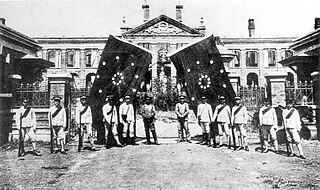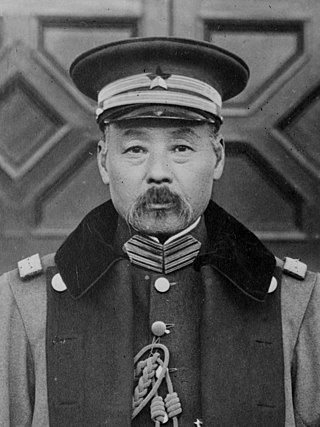
Yuan Shikai was a Chinese general and statesman who served as Prime Minister of the Imperial Cabinet, the second provisional president of the Republic of China, head of the Beiyang government from 1912 to 1916 and Emperor of China from 1915 to 1916. A major political figure during the late Qing dynasty, he spearheaded a number of major modernisation programs and reforms and played a decisive role in securing the abdication of the Xuantong Emperor in 1912, which marked the collapse of the Qing monarchy and the end of imperial rule in China.

The chancellor of Austria, officially the federal chancellor the Republic of Austria, is the head of government of the Republic of Austria.

The premier of China, officially the Premier of the State Council of the People's Republic of China, is the head of government of the People's Republic of China (PRC) and leader of the State Council. This post was established in 1911 near the end of the Qing dynasty, but the current post dates to 1954, five years after the establishment of the PRC. The premier is the third-highest ranking official in China's political system after the general secretary of the Chinese Communist Party and the president, and holds the highest rank in the civil service of the central government.

The Wuchang Uprising was an armed rebellion against the ruling Qing dynasty that took place in Wuchang in the Chinese province of Hubei on 10 October 1911, beginning the Xinhai Revolution that successfully overthrew China's last imperial dynasty. It was led by elements of the New Army, influenced by revolutionary ideas from Tongmenghui. The uprising and the eventual revolution directly led to the downfall of the Qing dynasty with almost three centuries of imperial rule, and the establishment of the Republic of China (ROC), which commemorates the anniversary of the uprising's outbreak on 10 October as the National Day of the Republic of China.

The 1911 Revolution, also known as the Xinhai Revolution or Hsinhai Revolution, ended China's last imperial dynasty, the Qing dynasty, and led to the establishment of the Republic of China (ROC). The revolution was the culmination of a decade of agitation, revolts, and uprisings. Its success marked the collapse of the Chinese monarchy, the end of over two millennia of imperial rule in China and the 200-year reign of the Qing, and the beginning of China's early republican era.

The Beiyang Army, named after the Beiyang region, was a Western-style Imperial Chinese Army established by the Qing dynasty in the early 20th century. It was the centerpiece of a general reconstruction of the Qing military system in the wake of the Boxer Rebellion and the First Sino-Japanese War, becoming the dynasty's first regular army in terms of its training, equipment, and structure. The Beiyang Army played a major role in Chinese politics for at least three decades and arguably right up to 1949. It made the 1911 Revolution against the Qing dynasty possible, and, by dividing into warlord factions known as the Beiyang clique, ushered in a period of regional division.

Zaifeng, also known as Tsai Feng, Prince of Ch'ün, formally known by his title Prince Chun, was a Manchu prince and regent of the late Qing dynasty. He was a son of Yixuan, the seventh son of the Daoguang Emperor, and the father of Puyi, the Last Emperor. He served as prince regent from 1908 to 1911 during the reign of his son until the Qing dynasty was overthrown by the Xinhai Revolution in 1911.

Yikuang, formally known as Prince Qing, was a Manchu noble and politician of the Qing dynasty. He served as the first Prime Minister of the Imperial Cabinet, an office created in May 1911 to replace the Grand Council.

The Grand Council or Junji Chu, officially the Banli Junji Shiwu Chu, was an important policy-making body of China during the Qing dynasty. It was established in 1733 by the Yongzheng Emperor. The council was originally in charge of military affairs, but gradually attained a more important role and eventually attained the role of a privy council, eclipsing the Grand Secretariat in function and importance, which is why it has become known as the "Grand Council" in English.

Cen Chunxuan, courtesy name Yunjie, was a Zhuang Chinese politician who lived in the late Qing dynasty and Republic of China.

Zaize, born Zaijiao, courtesy name Yinping, was a Manchu noble of the Qing dynasty. He is best known for supporting reforms and advocating the adoption of a constitutional monarchy system in the final years of the Qing dynasty.

Feng Guozhang was a Chinese general and politician in the late Qing dynasty and early republican China who was Vice President from 1916 to 1917 and then acting President of the Republic of China from 1917 to 1918. He emerged as one of the senior commanders of the Beiyang Army and is considered the founder of one of the main warlord factions, the Zhili clique, that vied for control of the internationally recognized government in China during the Warlord Era.

Late Qing reforms, commonly known as New Policies of the late Qing dynasty, or New Deal of the late Qing dynasty, simply referred to as New Policies, were a series of cultural, economic, educational, military, diplomatic, and political reforms implemented in the last decade of the Qing dynasty to keep the dynasty in power after the invasions of the great powers of the Eight Nation Alliance in league with the ten provinces of the Southeast Mutual Protection during the Boxer Rebellion.
The Cabinet of Prince Qing was the first cabinet of the Qing dynasty and of China, formed as part of the Qing state's reforms to create a constitutional monarchy in the early 20th century. It was active from 8 May to 1 November 1911, led by the Prime Minister of the Imperial Cabinet, Yikuang. It initially consisted of thirteen members, of which nine were Manchus while only four were Han Chinese. As a result, it remained unpopular among the people and was nicknamed the "Princes' Cabinet" or "Imperial Family Cabinet"(皇族内阁; 皇族內閣; Huángzú Nèigé) by its critics.

The Qing dynasty held its first set of provincial assembly elections from February to June 1909. Following a lengthy period of political turmoil and the failure of the 1898 Hundred Days' Reform, the constitutionalist movement gained approval from the imperial court and Empress Dowager Cixi in the aftermath of the Boxer Rebellion. Following administrative and bureaucratic reform, such as the abolition of the imperial examination system in 1905, the Qing government created the Constitutional Commission in preparation for a twelve-year transition from absolutism to a constitutional monarchy. Seeing local self-governance as a valuable initial step towards constitutionalism, the Commission received imperial approval in 1907 to create provincial assemblies.

The Advisory Council, also known as the Government Advisory Council, Political Advisory Council, or Political Advisory Board, was a preparatory body for the parliament established in 1910. It was part of the New Policies in the late Qing dynasty, of which the Qing court was moving toward the implementation of a constitution. In September 1907, the Guangxu Emperor promulgated a decree on the setting up of the Advisory Council, following by the provincial Consultative Bureaus in October.
The political systems of Imperial China can be divided into a state administrative body, provincial administrations, and a system for official selection. The three notable tendencies in the history of Chinese politics includes, the convergence of unity, the capital priority of absolute monarchy, and the standardization of official selection. Moreover, there were early supervisory systems that were originated by local factions, as well as other political systems worthy of mention.

China was a monarchy from prehistoric times up to 1912, when a republic was established. The succession of legendary monarchs of China were non-hereditary. Dynastic rule began c. 2070 BC when Yu the Great established the Xia dynasty, and monarchy lasted until 1912 when dynastic rule collapsed together with the monarchical government. Various attempts at preserving and restoring the Chinese monarchy occurred during and following the Xinhai Revolution, but these regimes were short-lived and lacked widespread recognition.
The Imperial Edict of the Abdication of the Qing Emperor was an official decree issued by the Empress Dowager Longyu on behalf of the six-year-old Xuantong Emperor, the last emperor of the Qing dynasty of China, on 12 February 1912, as a response to the Xinhai Revolution. The revolution led to the self-declared independence of 13 southern Chinese provinces and the subsequent peace negotiation between the rest of Qing China and the collective of the southern provinces.




















